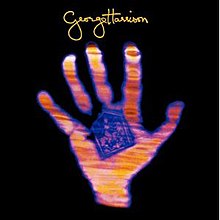| Living in the Material World | ||||
|---|---|---|---|---|
 | ||||
| Studio album by | ||||
| Released | 30 May 1973 | |||
| Recorded |
| |||
| Studio | ||||
| Genre | ||||
| Length | 43:55 | |||
| Label | Apple | |||
| Producer | George Harrison (with Phil Spector on "Try Some, Buy Some") | |||
| George Harrison chronology | ||||
| ||||
| Singles from Living in the Material World | ||||
| ||||
Living in the Material World is the fourth studio album by the English musician George Harrison, released in 1973 on Apple Records. As the follow-up to 1970's critically acclaimed All Things Must Pass and his pioneering charity project, the Concert for Bangladesh, it was among the most highly anticipated releases of that year. The album was certified gold by the Recording Industry Association of America two days after release, on its way to becoming Harrison's second number 1 album in the United States, and produced the international hit "Give Me Love (Give Me Peace on Earth)". It also topped albums charts in Canada and Australia, and reached number 2 in Britain.
Living in the Material World is notable for the uncompromising lyrical content of its songs, reflecting Harrison's struggle for spiritual enlightenment against his status as a superstar, as well as for what many commentators consider to be the finest guitar and vocal performances of his career. In contrast with All Things Must Pass, Harrison scaled down the production for Material World, using a core group of musicians comprising Nicky Hopkins, Gary Wright, Klaus Voormann and Jim Keltner. Ringo Starr, John Barham and Indian classical musician Zakir Hussain were among the album's other contributors.
Upon release, Rolling Stone described it as a "pop classic", a work that "stands alone as an article of faith, miraculous in its radiance".[1] Most contemporary reviewers consider Living in the Material World to be a worthy successor to All Things Must Pass, even if it inevitably falls short of Harrison's grand opus. Author Simon Leng refers to the album as a "forgotten blockbuster", representing "the close of an age, the last offering of the Beatles' London era".[2] EMI reissued the album in 2006, in remastered form with bonus tracks, and released a deluxe-edition CD/DVD set that included film clips of four songs. A newly remixed and expanded edition was released in 2024 to celebrate its 50th anniversary.